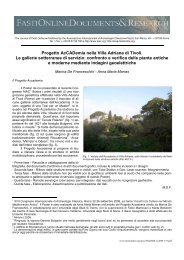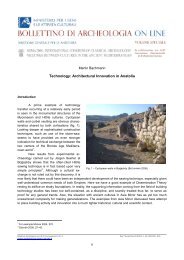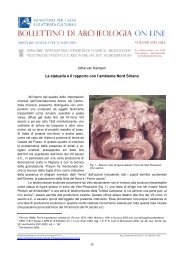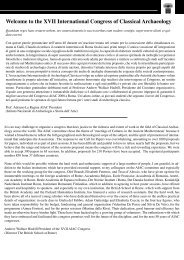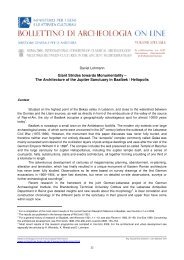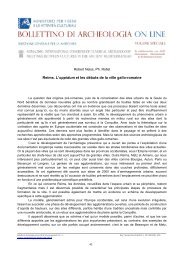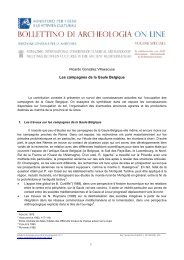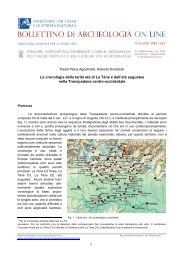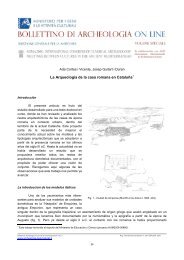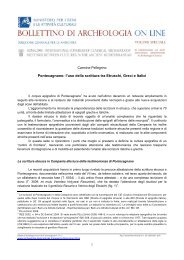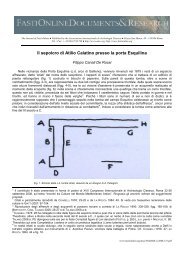Sarcophagi in Roman Britain - Bollettino di archeologia on line
Sarcophagi in Roman Britain - Bollettino di archeologia on line
Sarcophagi in Roman Britain - Bollettino di archeologia on line
You also want an ePaper? Increase the reach of your titles
YUMPU automatically turns print PDFs into web optimized ePapers that Google loves.
XVII Internati<strong>on</strong>al C<strong>on</strong>gress of Classical Archaeology, Roma 22-26 Sept. 2008Sessi<strong>on</strong>: <str<strong>on</strong>g>Roman</str<strong>on</strong>g> and Barbarianrelatively low, several examples recently excavated<str<strong>on</strong>g>in</str<strong>on</strong>g> Newcastle show that not all sarcophagic<strong>on</strong>ta<str<strong>on</strong>g>in</str<strong>on</strong>g>ed rich burials. The first ofthese, with an unsealed lid, c<strong>on</strong>ta<str<strong>on</strong>g>in</str<strong>on</strong>g>ed the skelet<strong>on</strong>of a child and a possible sec<strong>on</strong>dary burialbut no grave goods. The sec<strong>on</strong>d, this time withan unopened lead-sealed lid, c<strong>on</strong>ta<str<strong>on</strong>g>in</str<strong>on</strong>g>ed theburial of an adult, probably female with a jethairp<str<strong>on</strong>g>in</str<strong>on</strong>g> be<str<strong>on</strong>g>in</str<strong>on</strong>g>g the <strong>on</strong>ly surviv<str<strong>on</strong>g>in</str<strong>on</strong>g>g grave good 35 .These sarcophagi <str<strong>on</strong>g>di</str<strong>on</strong>g>d not, therefore, protectvaluable grave goods. Instead, they were placedclose to and well above the level of a <str<strong>on</strong>g>Roman</str<strong>on</strong>g>road, possibly that runn<str<strong>on</strong>g>in</str<strong>on</strong>g>g out of the nearbytown of P<strong>on</strong>s Aelius; they were obviously<str<strong>on</strong>g>in</str<strong>on</strong>g>tended to be highly visible. These examplesshow that these undecorated pieces were notmerely protective. Although certa<str<strong>on</strong>g>in</str<strong>on</strong>g>ly functi<strong>on</strong>al<str<strong>on</strong>g>in</str<strong>on</strong>g> this regard, there is suggestive evidence thatthey could have an ad<str<strong>on</strong>g>di</str<strong>on</strong>g>ti<strong>on</strong>al symbolicmean<str<strong>on</strong>g>in</str<strong>on</strong>g>g.The overwhelm<str<strong>on</strong>g>in</str<strong>on</strong>g>g majority of sarcophagiused <str<strong>on</strong>g>in</str<strong>on</strong>g> Brita<str<strong>on</strong>g>in</str<strong>on</strong>g> were locally carved fromnative materials. These are listed <str<strong>on</strong>g>in</str<strong>on</strong>g> Table 2.Abb. 2 – Distributi<strong>on</strong> map of <str<strong>on</strong>g>Roman</str<strong>on</strong>g>o-British sarcophagi.The <str<strong>on</strong>g>di</str<strong>on</strong>g>stributi<strong>on</strong> of the known examples ismapped <str<strong>on</strong>g>in</str<strong>on</strong>g> Figure 2 even though documentati<strong>on</strong>exists for <strong>on</strong>ly a small porti<strong>on</strong> of the total 36 . Though the st<strong>on</strong>e type has been analysed <str<strong>on</strong>g>in</str<strong>on</strong>g> <strong>on</strong>ly a handful ofcases some <str<strong>on</strong>g>in</str<strong>on</strong>g>terest<str<strong>on</strong>g>in</str<strong>on</strong>g>g results emerge. Where suitable local st<strong>on</strong>e was available sarcophagi were carvedfrom it, as <strong>on</strong>e would expect: this is the case with oolitic limest<strong>on</strong>e <str<strong>on</strong>g>in</str<strong>on</strong>g> Gloucestershire and Somerset andMillst<strong>on</strong>e grit at York 37 . At Cirencester, the Bath Gate cemetery is imme<str<strong>on</strong>g>di</str<strong>on</strong>g>ately adjacent to the city’s ma<str<strong>on</strong>g>in</str<strong>on</strong>g>quarries so transport costs were kept to an absolute m<str<strong>on</strong>g>in</str<strong>on</strong>g>imum 38 . However, the fact that value was attachedto st<strong>on</strong>e as a me<str<strong>on</strong>g>di</str<strong>on</strong>g>um <str<strong>on</strong>g>in</str<strong>on</strong>g> itself is illustrated by the examples from the south-east of the prov<str<strong>on</strong>g>in</str<strong>on</strong>g>ce 39 . Here,limest<strong>on</strong>e had to be imported. St<strong>on</strong>e from the quarries at Barnack and Ancaster, <str<strong>on</strong>g>in</str<strong>on</strong>g> northern Cambridgeshireand L<str<strong>on</strong>g>in</str<strong>on</strong>g>colnshire respectively, is used <str<strong>on</strong>g>in</str<strong>on</strong>g> L<strong>on</strong>d<strong>on</strong>, southern Cambridgeshire and Essex, <str<strong>on</strong>g>in</str<strong>on</strong>g> the last caseal<strong>on</strong>gside oolitic limest<strong>on</strong>e, the closest source of which is <str<strong>on</strong>g>in</str<strong>on</strong>g> Oxfordshire 40 . Some <str<strong>on</strong>g>in</str<strong>on</strong>g><str<strong>on</strong>g>di</str<strong>on</strong>g>cati<strong>on</strong> of the cost ofmov<str<strong>on</strong>g>in</str<strong>on</strong>g>g this material can be ga<str<strong>on</strong>g>in</str<strong>on</strong>g>ed from later sources. The st<strong>on</strong>e used for the porch of Corpus ChristiCollege, Cambridge, <str<strong>on</strong>g>in</str<strong>on</strong>g> 1583–1584, for example, which came from quarries <str<strong>on</strong>g>in</str<strong>on</strong>g> the vic<str<strong>on</strong>g>in</str<strong>on</strong>g>ity of Barnack andnearby Weld<strong>on</strong>, cost 75% of its orig<str<strong>on</strong>g>in</str<strong>on</strong>g>al value to be moved 16km overland 41 . When <strong>on</strong>e c<strong>on</strong>siders that35 This <str<strong>on</strong>g>in</str<strong>on</strong>g>formati<strong>on</strong> comes from the prelim<str<strong>on</strong>g>in</str<strong>on</strong>g>ary report <strong>on</strong> the excavati<strong>on</strong> <str<strong>on</strong>g>in</str<strong>on</strong>g> summer 2008 of the sarcophagi at the BEMCO site, Claver<str<strong>on</strong>g>in</str<strong>on</strong>g>gPlaces, Newcastle up<strong>on</strong> Tyne, prepared by the Archaeological Services of the University of Durham.36 S<str<strong>on</strong>g>in</str<strong>on</strong>g>ce so many of these pieces were recorded <str<strong>on</strong>g>in</str<strong>on</strong>g> the 18 th , 19 th and early 20 th centuries details of their <str<strong>on</strong>g>di</str<strong>on</strong>g>scovery are often patchy.37 See GRAY 1922, 371–375, WILLMORE 1939, 158–161, and VINER, LEECH 1982, 88–92; <strong>on</strong> the Millst<strong>on</strong>e grit examples seen RAMM1958, 402–403 and 412–413, DICKINSON, WENHAM 1958, 291–292, WENHAM 1960, 317–318 and 327 (Appen<str<strong>on</strong>g>di</str<strong>on</strong>g>x 3), and WENHAM 1968,40–42.38 VINER, LEECH 1982, 88–90; see VANHAVERBEKE, WAELKENS 2002 for a similar situati<strong>on</strong> at Hierapolis <str<strong>on</strong>g>in</str<strong>on</strong>g> Phrygia where over 1474sarcophagi have been identified to date, 89.9% of them carved from travert<str<strong>on</strong>g>in</str<strong>on</strong>g>e quarried <strong>on</strong> the edge of the north-western necropolis.39 C<strong>on</strong>trary to the view of Esm<strong>on</strong>de Cleary (1987, 12), I th<str<strong>on</strong>g>in</str<strong>on</strong>g>k that even <str<strong>on</strong>g>in</str<strong>on</strong>g> areas well-supplied with st<strong>on</strong>e resources, st<strong>on</strong>e coff<str<strong>on</strong>g>in</str<strong>on</strong>g>s wouldbe more expensive than wooden <strong>on</strong>es.40 On L<strong>on</strong>d<strong>on</strong>, see RCHM England 1928, 157 and 163, and TOYNBEE 1964, 210–211; <strong>on</strong> Cambridgeshire, WALKER 1908, 273–284, FELL1955, 13–23, RUDD, DAINES 1971, 1–8, LIVERSIDGE 1977, 15 and 23, and TAYLOR 1984, 15; and <strong>on</strong> Essex, POWELL 1963, 146–147, andJONES 1979, 26–30.41 ALEXANDER 1995, 127.Bollett<str<strong>on</strong>g>in</str<strong>on</strong>g>o <str<strong>on</strong>g>di</str<strong>on</strong>g> Archeologia <strong>on</strong> l<str<strong>on</strong>g>in</str<strong>on</strong>g>e I 2010/ Volume speciale E / E10 / 2 Reg. Tribunale Roma 05.08.2010 n. 330 ISSN 2039 - 0076www.<str<strong>on</strong>g>archeologia</str<strong>on</strong>g>.beniculturali.it/pages/pubblicazi<strong>on</strong>i.html19



